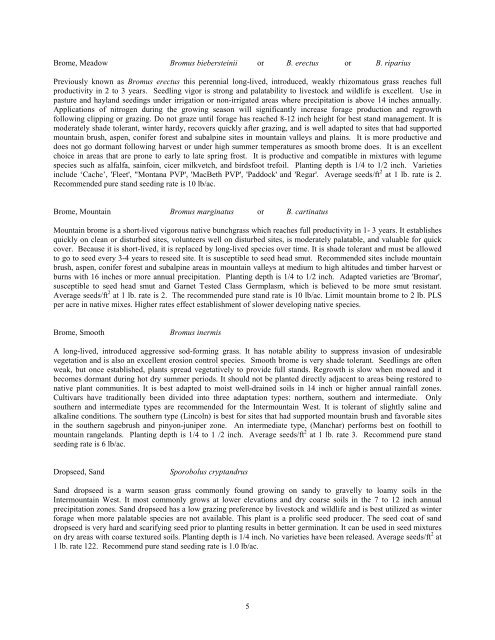Idaho Plant Materials Technical Note No. 24
Idaho Plant Materials Technical Note No. 24
Idaho Plant Materials Technical Note No. 24
You also want an ePaper? Increase the reach of your titles
YUMPU automatically turns print PDFs into web optimized ePapers that Google loves.
Brome, Meadow Bromus biebersteinii or B. erectus or B. riparius<br />
Previously known as Bromus erectus this perennial long-lived, introduced, weakly rhizomatous grass reaches full<br />
productivity in 2 to 3 years. Seedling vigor is strong and palatability to livestock and wildlife is excellent. Use in<br />
pasture and hayland seedings under irrigation or non-irrigated areas where precipitation is above 14 inches annually.<br />
Applications of nitrogen during the growing season will significantly increase forage production and regrowth<br />
following clipping or grazing. Do not graze until forage has reached 8-12 inch height for best stand management. It is<br />
moderately shade tolerant, winter hardy, recovers quickly after grazing, and is well adapted to sites that had supported<br />
mountain brush, aspen, conifer forest and subalpine sites in mountain valleys and plains. It is more productive and<br />
does not go dormant following harvest or under high summer temperatures as smooth brome does. It is an excellent<br />
choice in areas that are prone to early to late spring frost. It is productive and compatible in mixtures with legume<br />
species such as alfalfa, sainfoin, cicer milkvetch, and birdsfoot trefoil. <strong>Plant</strong>ing depth is 1/4 to 1/2 inch. Varieties<br />
include ‘Cache’, 'Fleet', "Montana PVP', 'MacBeth PVP', 'Paddock' and 'Regar'. Average seeds/ft 2 at 1 lb. rate is 2.<br />
Recommended pure stand seeding rate is 10 lb/ac.<br />
Brome, Mountain Bromus marginatus or B. cartinatus<br />
Mountain brome is a short-lived vigorous native bunchgrass which reaches full productivity in 1- 3 years. It establishes<br />
quickly on clean or disturbed sites, volunteers well on disturbed sites, is moderately palatable, and valuable for quick<br />
cover. Because it is short-lived, it is replaced by long-lived species over time. It is shade tolerant and must be allowed<br />
to go to seed every 3-4 years to reseed site. It is susceptible to seed head smut. Recommended sites include mountain<br />
brush, aspen, conifer forest and subalpine areas in mountain valleys at medium to high altitudes and timber harvest or<br />
burns with 16 inches or more annual precipitation. <strong>Plant</strong>ing depth is 1/4 to 1/2 inch. Adapted varieties are 'Bromar',<br />
susceptible to seed head smut and Garnet Tested Class Germplasm, which is believed to be more smut resistant.<br />
Average seeds/ft 2 at 1 lb. rate is 2. The recommended pure stand rate is 10 lb/ac. Limit mountain brome to 2 lb. PLS<br />
per acre in native mixes. Higher rates effect establishment of slower developing native species.<br />
Brome, Smooth<br />
Bromus inermis<br />
A long-lived, introduced aggressive sod-forming grass. It has notable ability to suppress invasion of undesirable<br />
vegetation and is also an excellent erosion control species. Smooth brome is very shade tolerant. Seedlings are often<br />
weak, but once established, plants spread vegetatively to provide full stands. Regrowth is slow when mowed and it<br />
becomes dormant during hot dry summer periods. It should not be planted directly adjacent to areas being restored to<br />
native plant communities. It is best adapted to moist well-drained soils in 14 inch or higher annual rainfall zones.<br />
Cultivars have traditionally been divided into three adaptation types: northern, southern and intermediate. Only<br />
southern and intermediate types are recommended for the Intermountain West. It is tolerant of slightly saline and<br />
alkaline conditions. The southern type (Lincoln) is best for sites that had supported mountain brush and favorable sites<br />
in the southern sagebrush and pinyon-juniper zone. An intermediate type, (Manchar) performs best on foothill to<br />
mountain rangelands. <strong>Plant</strong>ing depth is 1/4 to 1 /2 inch. Average seeds/ft 2 at 1 lb. rate 3. Recommend pure stand<br />
seeding rate is 6 lb/ac.<br />
Dropseed, Sand<br />
Sporobolus cryptandrus<br />
Sand dropseed is a warm season grass commonly found growing on sandy to gravelly to loamy soils in the<br />
Intermountain West. It most commonly grows at lower elevations and dry coarse soils in the 7 to 12 inch annual<br />
precipitation zones. Sand dropseed has a low grazing preference by livestock and wildlife and is best utilized as winter<br />
forage when more palatable species are not available. This plant is a prolific seed producer. The seed coat of sand<br />
dropseed is very hard and scarifying seed prior to planting results in better germination. It can be used in seed mixtures<br />
on dry areas with coarse textured soils. <strong>Plant</strong>ing depth is 1/4 inch. <strong>No</strong> varieties have been released. Average seeds/ft 2 at<br />
1 lb. rate 122. Recommend pure stand seeding rate is 1.0 lb/ac.<br />
5
















